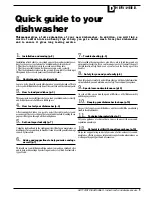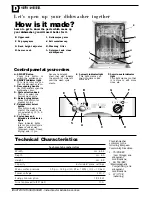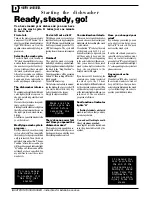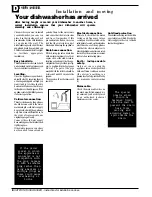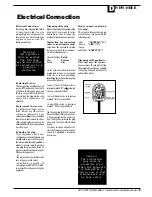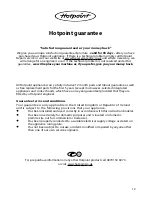
HOTPOINT DISHWASHER - Instructions for installation and use
3
D
ISHWASHER
How to load your dishes
First of all.
Before placing the dishes in the
racks, remove the largest scraps
of food left over on your plates,
you will thus avoid blocking the
filter, which would reduce the
efficacy of the wash.
If the saucepans and frying pans
are very dirty, allow them to soak
before being washed. To make it
easier to load your dishes, pull the
racks out.
What goes into the
lower rack?
We recommend you place the
most difficult dishes to wash into
the lower rack: saucepans, lids,
soup dishes and plates (a load
example is shown in the photo).
Serving dishes and large
lids:
place them on the sides
of the rack.
Saucepans, salad bowls:
must always be placed upside
down
Very deep dishes:
place
them obliquely, thus allowing
water to run down them and
cleaning them better
The lower rack has tip-up sectors
(see figure
B
), so you can place
even more saucepans and frying
pans or make room for the larger
ones.
Place the cutlery with the handles
at the bottom; if the basket is the
one with side inserts, then insert
the tea spoons one by one into the
slots (see figure A).
It is best if you place longer utensils
horizontally at the front of the upper
rack.
After loading the dishes, remember
to check that the blades on the
sprayer arms can turn freely
without hitting against any dishes.
What goes into the
upper rack?
Place delicate and lightweight
dishes in the upper rack: glasses,
tea cups and coffee cups, saucers -
but plates too - shallow salad bowls,
slightly dirty frying pans and
shallow pans.
Position lightweight dishes in such
as way as to avoid their being
moved by the spray of water.
How to adjust the top
rack.
The upper rack can be set in high
or low position to enable you to
organise your dishes effortlessly.
Before washing, a few small steps can help you get a better wash and keep your dishwasher for longer.
Remove the largest scraps of food left over on your plates, soak saucepans and frying pans with tough
incrustations. After loading your dishes, make sure the blades on the sprayer arm turn well
1
2
F i g . B
Fig. A
upper rack
lower rack
Load examples
upper rack
lower rack
There are two handles on the sides
of the upper rack: use these to
adjust its height (see fig. C)
F i g . C


